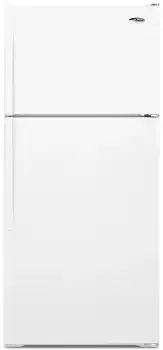Documents: Go to download!
User Manual
- User Manual - (English, French, Spanish)
- Warranty - (English)
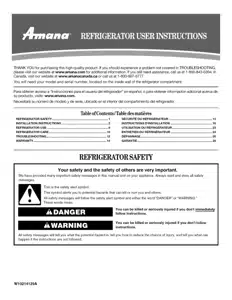
User manual Refrigerator
INSTALLATION INSTRUCTIONS
Remove the Packaging
- Remove tape and glue residue from surfaces before turning on the refrigerator. Rub a small amount of liquid dish soap over the adhesive with your fingers. Wipe with warm water and dry.
- Do not use sharp instruments, rubbing alcohol, flammable fluids, or abrasive cleaners to remove tape or glue. These products can damage the surface of your refrigerator. For more information, see “Refrigerator Safety.”
- On some models, shelves, bins, door shelf rails, and other feature parts may be packaged in the Interior FeaturePak. Follow the instructions contained in the package for proper assembly.
- There are four bolts that secure the refrigerator to the shipping case. Keep these bolts because they are the refrigerator's leveling legs.
- Dispose of/recycle all packaging materials.
IMPORTANT: Do not remove the white foam air return insert that is located behind the control panel on the ceiling of the refrigerator (on some models). The insert is part of the refrigerator and not part of the packing material. If the insert is removed, ice may migrate down from the freezer and cause icicles to form.
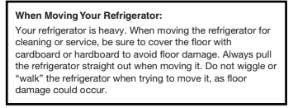
Clean Before Using
After you remove all of the package materials, clean the inside of your refrigerator before using it. See the cleaning instructions in “Refrigerator Care.”

Location Requirements
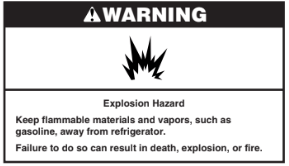
To ensure proper ventilation for your refrigerator, allow for a 1⁄2" (12.70 mm) space on each side. Allow 3" (7.5 cm) of space between overhead cabinets and refrigerator top. Allow at least 1" (25.40 mm) between back of cabinet and the wall. If your refrigerator has an ice maker, make sure you leave some extra space at the back for the water line connections.
- If you are installing your refrigerator next to a fixed wall, leave 2" (5.08 cm) minimum on the hinge side (depending on your model) to allow for the door to swing open.
- Level the refrigerator. See “Adjust the Doors.”
NOTE: It is recommended that you do not install the refrigerator near an oven, radiator, or other heat source. Do not install in a location where the temperature will fall below 55°F (13°C).
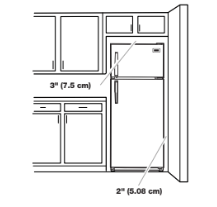
Electrical Requirements
Before you move your refrigerator into its final location, it is important to make sure you have the proper electrical connection.
Recommended Grounding Method
- A 115 Volt, 60 Hz., AC only 15- or 20-amp fused, grounded electrical supply is required. It is recommended that a separate circuit serving only your refrigerator be provided. Use an outlet that cannot be turned off by a switch. Do not use an extension cord.
- NOTE: Before performing any type of installation, cleaning, or removing a light bulb, turn the control (Thermostat, Refrigerator or Freezer Control depending on the model) OFF and then disconnect the refrigerator from the electrical source. When you are finished, reconnect the refrigerator to the electrical source and reset the control (Thermostat, Refrigerator or Freezer Control depending on the model) to the desired setting. See “Using the Control(s).”
Water Supply Requirements
Read all directions before you begin.
IMPORTANT:
- If you turn the refrigerator on before the water line is connected, turn the ice maker OFF.
- All installations must meet local plumbing code requirements.
- Use copper tubing and check for leaks. Install copper tubing only in areas where the household temperatures will remain above freezing.
TOOLS NEEDED: Flat-blade screwdriver, 7⁄16" and 1⁄2" open-end wrenches or 2 adjustable wrenches, 1⁄4" nut driver and drill bit, cordless drill. Gather the required tools and parts before starting installation. Read and follow the instructions provided with any tools listed.
NOTE: Your refrigerator dealer has a kit available with a 1⁄4" (6.35 mm) saddle-type shutoff valve, a union, and copper tubing. Before purchasing, make sure a saddle-type valve complies with your local plumbing codes. Do not use a piercing-type or 3⁄16" (4.76 mm) saddle valve which reduces water flow and clogs more easily.
Water Pressure
A cold water supply with water pressure of between 30 and 120 psi (207 and 827 kPa) is required to operate the ice maker. If you have questions about your water pressure, call a licensed, qualified plumber.
Reverse Osmosis Water Supply
If a reverse osmosis water filtration system is connected to your cold water supply, the water pressure to the reverse osmosis system needs to be a minimum of 40 to 60 psi (276 to 414 kPa).
If the ice maker is still not operating properly:
- Check to see whether the sediment filter in the reverse osmosis system is blocked. Replace the filter if necessary.
- Allow the storage tank on the reverse osmosis system to refill after heavy usage.
If you have questions about your water pressure, call a licensed, qualified plumber.
Connect the Water Supply (on some models)
Read all directions before you begin.
IMPORTANT: If you turn the refrigerator on before the water line is connected, turn the ice maker OFF.
Connect to Water Line
- Unplug refrigerator or disconnect power.
- Turn OFF main water supply. Turn ON nearest faucet long enough to clear line of water.
- Locate a 1⁄2" to 11⁄4" (1.27 cm to 3.18 cm) vertical cold water pipe near the refrigerator.
IMPORTANT:
Make sure it is a cold water pipe.
Horizontal pipe will work, but drill on the top side of the pipe, not the bottom. This will help keep water away from the drill and normal sediment from collecting in the valve.
- Determine the length of copper tubing you will need. Measure from the connection on lower left rear of refrigerator to the water pipe. Add 7 ft (2.1 m) to allow for cleaning. Use 1⁄4" (6.35 mm) O.D. (outside diameter) copper tubing. Be sure both ends of copper tubing are cut square.
- Using a cordless drill, drill a 1⁄4" hole in the cold water pipe you have selected.

- Fasten the shutoff valve to the cold water pipe with the pipe clamp. Be sure the outlet end is solidly in the 1⁄4" drilled hole in the water pipe and that the washer is under the pipe clamp. Tighten the packing nut. Tighten the pipe clamp screws slowly and evenly so washer makes a watertight seal. Do not overtighten or you may crush the copper tubing.
- Slip the compression sleeve and compression nut on the copper tubing as shown. Insert the end of the tubing into the outlet end squarely as far as it will go. Screw compression nut onto outlet end with adjustable wrench. Do not overtighten.
- Place the free end of the tubing in a container or sink, and turn ON the main water supply. Flush the tubing until water is clear. Turn OFF the shutoff valve on the water pipe. Coil the copper tubing.
Connect to Refrigerator
NOTE: On kit models, assemble water valve to refrigerator per kit instructions.
Style 1
- Unplug refrigerator or disconnect power.
- Attach the copper tube to the valve inlet using a compression nut and sleeve as shown. Tighten the compression nut. Do not overtighten.
- Use the tube clamp on the back of the refrigerator to secure the tubing to the refrigerator as shown. This will help avoid damage to the tubing when the refrigerator is pushed back against the wall.
- Turn shutoff valve ON.
- Check for leaks. Tighten any connections (including connections at the valve) or nuts that leak.

- The ice maker is equipped with a built-in water strainer. If your water conditions require a second water strainer, install it in the 1⁄4" (6.35 mm) water line at either tube connection. Obtain a water strainer from your nearest appliance dealer.
Style 2
- Unplug refrigerator or disconnect power.
- Disconnect the tube clamp on the back of the product and insert the copper tubing through the clamp as shown.
- Attach the copper tube to the valve inlet using a compression nut and sleeve as shown.
- Tighten the compression nut. Do not overtighten. Reattach the tube clamp and tube to the back of the cabinet.
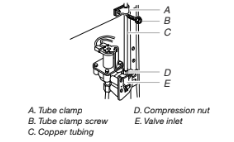
- Turn shutoff valve ON. Check for leaks. Tighten any connections (including connections at the valve) or nuts that leak.
- The ice maker is equipped with a built-in water strainer. If your water conditions require a second water strainer, install it in the 1⁄4" (6.35 mm) water line at either tube connection. Obtain a water strainer from your nearest appliance dealer.
Refrigerator Doors
TOOLS NEEDED: 5⁄16" hex-head socket wrench, #2 Phillips screwdriver, flat-blade screwdriver, 5⁄16" open-end wrench, flat 2" putty knife.
IMPORTANT:
- Before you begin, turn the refrigerator control OFF. Unplug refrigerator or disconnect power.
- Remove food and adjustable door or utility bins from doors.
- If you are only removing and replacing the doors, see the “Remove Doors and Hinges” and “Replace Doors and Hinges” sections.
- Depending on your model, you may have standard (Style 1) or contoured (Style 2) doors. If you are also going to reverse the door swing, follow the instructions for the appropriate door style.
Remove Doors and Hinges

- Unplug refrigerator or disconnect power.
- Close the refrigerator door and keep both doors closed until you are ready to lift them free from the cabinet. NOTE: Provide additional support for the doors while the hinges are being moved. Do not depend on the door magnets to hold the doors in place while you are working.
- Remove the parts for the top hinge as shown in Top Hinge graphic. Lift the freezer door free from the cabinet.
- Remove the parts for the center hinge as shown in the Center Hinge graphic. Lift the refrigerator door free from the cabinet.
- Remove the parts for the bottom hinge as shown in the Bottom Hinge graphic.
Reverse Doors (optional)
IMPORTANT: If you want to reverse your doors so that they open in the opposite direction, follow these steps. If you are not reversing the doors, see “Replace Doors and Hinges.”
Style 1 - Standard
Graphics follow these instructions.
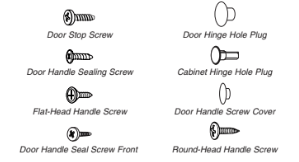
Cabinet
- Remove 5⁄16" hex-head hinge screws from handle side and move them to opposite side. See Graphic 1-1.
- Remove cabinet hinge hole plugs from cabinet top and move them to opposite side hinge holes as shown. See Graphic 1-2.
Freezer door
- Remove freezer handle assembly as shown. Keep all parts together. See Graphic 2.
- Remove door hinge hole plug. Move to opposite side as shown. See Graphic 3.
- Remove door handle sealing screws. Move to opposite side of freezer door as shown. See Graphic 4.
- Remove door stop. Move to opposite side of freezer door as shown. See Graphic 5.
- Position freezer handle on opposite side of freezer door. Assemble handle on door as shown. See Graphic 2.
- Tighten all screws. Set aside door until hinges and refrigerator compartment door are in place.
Refrigerator door
- Remove the screw cover. See Graphic 6.
- Remove refrigerator handle assembly as shown. Keep all parts together. See Graphic 6.
- Remove door hinge hole plug from refrigerator door. Move to opposite side hinge hole as shown. See Graphic 3.
- Remove door handle sealing screws. Move to opposite side of refrigerator door as shown. See Graphic 4.
- Remove door handle seal screw front. Move to opposite side of refrigerator door as shown. See Graphic 7.
- Remove door stop. Move to opposite side of refrigerator door as shown. See Graphic 5.
- Position refrigerator handle on opposite side of the refrigerator door as shown. See Graphic 6. Drive top two screws in handle first. Align lower portion of handle and drive bottom screw.
- Replace screw cover. See Graphic 6.
- Tighten all screws. Set aside refrigerator door until bottom hinge is installed on refrigerator.
Style 2 - Contoured
Graphics follow these instructions.

Cabinet
- Remove 5⁄16" hex-head hinge screws from handle side and move them to opposite side. See Graphic 1-1.
- Remove cabinet hinge hole plugs from the cabinet top and move them to opposite side hinge holes as shown. See Graphic 1-2.
Doors
- Remove door hinge hole plug from top of freezer door. Move to opposite side as shown. See Graphic 2.
- Remove door stop from both the freezer and refrigerator doors and move to the other side. See Graphic 3.
Replace Doors and Hinges
NOTE: Graphic may be reversed if door swing is reversed.
- Replace the parts for the bottom hinge as shown. Tighten screws. Replace the refrigerator door. NOTE: Provide additional support for the doors while the hinges are being moved. Do not depend on the door magnets to hold the doors in place while you are working.
- Assemble the parts for the center hinge as shown and tighten all screws. See Center Hinge graphic. Replace the freezer door.
- Assemble the parts for the top hinge as shown. See Top Hinge graphic. Do not tighten screws completely.
- Line up the doors so that the bottom of the freezer door aligns evenly with the top of the refrigerator door. Tighten all screws.
Final Steps
- Check all holes to make sure that hole plugs and screws are in place. Reinstall top hinge cover. See Top Hinge graphic.
- Plug into a grounded 3 prong outlet.
- Reset the controls. See “Using the Control(s).”
- Return all removable door parts to doors and food to refrigerator.
Style 1 - Standard
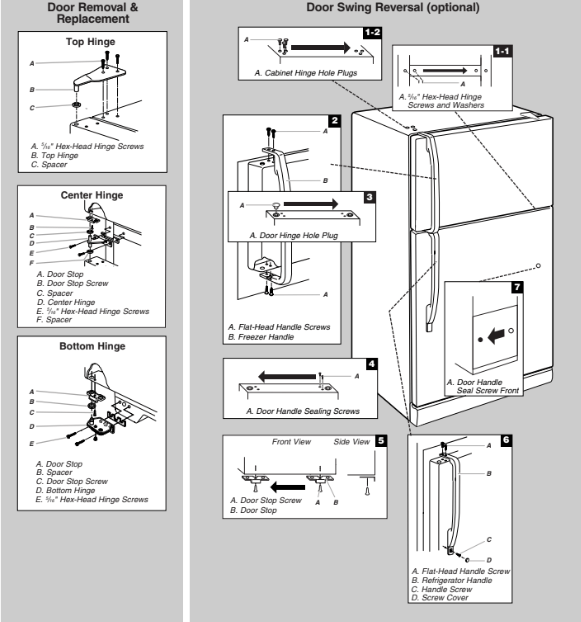
Adjust the Doors
Your refrigerator has two front adjustable rollers – one on the right and one on the left. If your refrigerator seems unsteady or you want the doors to close easier, adjust the refrigerator's tilt using the instructions below.
Depending on your model, your refrigerator may have leveling legs (Style 1) or leveling screws (Style 2). They are part of the front roller assemblies which are found at the base of the refrigerator on either side.
- Turn the leveling legs or leveling screws to the right to raise that side of the refrigerator or to the left to lower that side. It may take several turns to adjust the tilt of the refrigerator. NOTE: Having someone push against the top of the refrigerator takes some weight off the leveling screws and rollers. This makes it easier to adjust the screws.
- Open both doors again and be sure that they close as easily as you like. If not, tilt the refrigerator slightly more to the rear by turning both leveling screws to the right. It may take several more turns, and you should turn both leveling screws the same amount.
Style 1
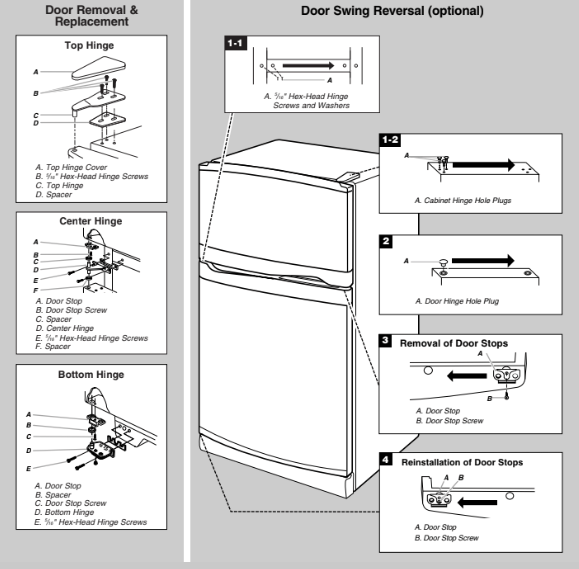
Style 2
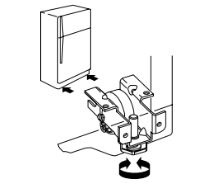
- Using a level, be sure that the refrigerator is still level side to side. Readjust if necessary.
REFRIGERATOR USE
Using the Control
The temperature control is located at the top of the refrigerator compartment. It controls the temperature in both the refrigerator and freezer compartments.
For your convenience, the Temperature Control is preset at the factory. When you first install your refrigerator, make sure that the control is still preset to the mid-setting as shown.
NOTE: To turn your refrigerator off, turn the refrigerator control to the word OFF or until the word OFF appears. Your product will not cool when the refrigerator control is set to OFF.
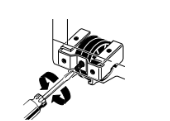
IMPORTANT:
- Give your refrigerator time to cool down completely before adding food. It is best to wait 24 hours before you put food into the refrigerator.
- If you add food before the refrigerator has cooled completely, your food may spoil. Adjusting the Refrigerator and Freezer Controls to a higher (colder) than recommended setting will not cool the compartments any faster.
Adjusting Controls
The mid-setting indicated in the previous section should be correct for normal household usage. The controls are set correctly when milk or juice is as cold as you like and when ice cream is firm.
If the temperature is too warm or too cold in the refrigerator or freezer, first check the air vents to be sure they are not blocked.
If you need to adjust temperatures, use the settings listed in the chart below as a guide. Wait at least 24 hours between adjustments and then recheck the temperatures.

Ice Maker
Turning the Ice Maker On/Off
- To turn the ice maker ON, simply lower the wire shutoff arm.
- To manually turn the ice maker OFF, lift the wire shutoff arm to the OFF (arm up) position and listen for the click.
- NOTE: Your ice maker has an automatic shutoff. As ice is made, the ice cubes will fill the ice storage bin and the ice cubes will raise the wire shutoff arm to the OFF (arm up) position. Do not force the wire shutoff arm up or down.
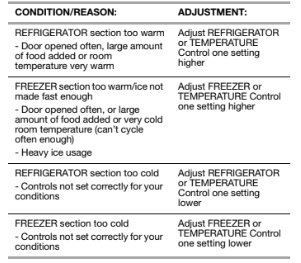
Ice Production Rate
- Allow 24 hours to produce the first batch of ice. Discard the first three batches of ice produced.
- The ice maker should produce approximately 8 to 12 batches of ice in a 24-hour period.
- To increase ice production, lower the freezer and refrigerator temperature. See “Using the Control(s).” Wait 24 hours between adjustments.
- For maximum ice production (on some models), push the switch to ICE PLUS. The ice maker should produce 16 to 20 batches of ice in a 24-hour period in the Ice Plus mode.
Remember
- The quality of your ice will be only as good as the quality of the water supplied to your ice maker. Avoid connecting the ice maker to a softened water supply. Water softener chemicals (such as salt) can damage parts of the ice maker and lead to poor quality ice. If a softened water supply cannot be avoided, make sure the water softener is operating properly and is well maintained.
- Do not use anything sharp to break up the ice in the bin. This can cause damage to the ice container and the dispenser mechanism.
- Do not store anything on top of or in the ice maker or ice bin.
REFRIGERATOR CARE
Cleaning

Both the refrigerator and freezer sections defrost automatically. However, clean both compartments about once a month to avoid buildup of odors. Wipe up spills immediately.
IMPORTANT:
- Because air circulates between both sections, any odors formed in one section will transfer to the other. You must thoroughly clean both sections to eliminate odors. To avoid odor transfer and drying out of food, wrap or cover foods tightly.
- For stainless steel models, stainless steel is corrosion- resistant and not corrosion-proof. To help avoid corrosion of your stainless steel, keep your surfaces clean by using the following cleaning instructions.
To Clean Your Refrigerator:
NOTE: Do not use abrasive or harsh cleaners such as window sprays, scouring cleansers, flammable fluids, muriatic acid, cleaning waxes, concentrated detergents, bleaches or cleansers containing petroleum products on exterior surfaces (doors and cabinet), plastic parts, interior and door liners or gaskets. Do not use paper towels, scouring pads, or other harsh cleaning tools.
- Unplug refrigerator or disconnect power.
- Hand wash, rinse, and dry removable parts and interior surfaces thoroughly. Use a clean sponge or soft cloth and a mild detergent in warm water.
- Clean the exterior surfaces.
Painted metal: Wash painted metal exteriors with a clean, soft cloth or sponge and a mild detergent in warm water. Rinse surfaces with clean, warm water and dry immediately to avoid water spots.
Stainless steel: Wash stainless steel surfaces with a clean, soft cloth or sponge and a mild detergent in warm water. Rinse surfaces with clean, warm water and dry immediately to avoid water spots.
NOTE: When cleaning stainless steel, always wipe with the grain to avoid cross-grain scratching.
- Clean the condenser coils regularly. Coils may need to be cleaned as often as every other month. This may help save energy.
Pull refrigerator out away from the wall. See “Unpack the Refrigerator.”
Vacuum coils when they are dusty or dirty.
Roll refrigerator back into place. Make sure to leave 1" (2.5 cm) between the cabinet back and the wall.
Check to see that the refrigerator is level.
- Plug in refrigerator or reconnect power.
Dry Erase Board (on some models)
Your Amana® JOTTM refrigerator is equipped with a special technology (Dry Erase) on the door’s surface, which allows you to draw and write on it and erase easily; to keep the refrigerator door in good condition, it is necessary to follow the instructions below:
IMPORTANT: Only the metal surface of the door is prepared with the Dry Erase technology, which is why the markers should not be used on any plastic parts or on the sides of the refrigerator. If markers are used by mistake on plastic parts or on the side of the refrigerator, it is recommended to clean immediately with liquid dish detergent and water.
- Remove the marker kit, which is included inside your refrigerator. Place the marker kit horizontally somewhere in your kitchen.
- For best results, use Crayola® brand dry erase markers in these recommended colors: black, blue, purple, orange, yellow or brown. Do not use red or green. Always use a marker designed for dry erase surfaces. IMPORTANT: Do not use permanent markers.
- The included markers are designed to be erased without water. The marker’s ink can be removed easily without water with a cotton cloth or, in its absence, with a sponge, detergent and water. If there is any ink residue left from prolonged exposure, clean with liquid dish detergent and water.
- Always use marker on the refrigerator’s clean surface (free of grease and dirt). For cleaning and care of your refrigerator, you should clean the ink residues from the dry erase surface at least once a month.
Changing the Light Bulbs
NOTE: Not all appliance bulbs will fit your refrigerator. Be sure to replace the bulb with one of the same size, shape, and wattage.
Refrigerator Light
- Unplug refrigerator or disconnect power.
- Reach behind the control panel and unscrew the bulb.
- Replace the bulb with a 40-watt appliance bulb.
- Plug in refrigerator or reconnect power.

Freezer Light
- Unplug refrigerator or disconnect power.
- Remove the freezer shelf.
- Remove the freezer light shield by pushing down.

- Remove the light bulb and replace with one of the same size, shape and wattage.
- Replace the light shield.
- Plug in refrigerator or reconnect power.
TROUBLESHOOTING
Refrigerator Operation
The refrigerator will not operate
- Power cord unplugged? Plug into a grounded 3 prong outlet.
- Is outlet working? Plug in a lamp to see if the outlet is working.
- Household fuse blown or circuit breaker tripped? Replace the fuse or reset the circuit breaker. If the problem continues, call an electrician.
- Control(s) on? Make sure the refrigerator control is on. See “Using the Control(s).”
- New installation? Allow 24 hours following installation for the refrigerator to cool completely.
NOTE: Adjusting the temperature control(s) to coldest setting will not cool the refrigerator more quickly.
The motor seems to run too much
- Your new refrigerator may run longer than your old one due to its high-efficiency compressor and fans. The unit may run even longer if the room is warm, a large food load is added, the door is opened often, or if the door has been left open.
The refrigerator seems noisy
Refrigerator noise has been reduced over the years. Due to this reduction, you may hear intermittent noises from your new refrigerator that you did not notice from your old model. Below are listed some normal sounds with explanations.
- Pulsating - fans/compressor adjusting to optimize performance.
- Hissing/Rattling - flow of refrigerant, movement of water lines, or from items placed on top of the refrigerator.
- Popping - contraction/expansion of inside walls, especially during initial cool-down.
- Water running/dripping - may be heard when ice melts during defrosting and water runs into the drain pan.
The door will not close completely
- Door blocked open? Move food packages away from door.
- Bin or shelf in the way? Push bin or shelf back in the correct position.
- Crisper cover in the way? Make sure the crisper cover is fully pushed in, so that the back rests on the supports.
The door is difficult to open
- Gaskets dirty or sticky? Clean gaskets and contact surfaces with mild soap and warm water. Rinse and dry with soft cloth.
Temperature and Moisture
Temperature is too warm
- New installation? Allow 24 hours following installation for the refrigerator to cool completely.
- Door opened often or left open? Allows warm air to enter refrigerator. Minimize door openings and keep door fully closed.
- Large load of food added? Allow several hours for refrigerator to return to normal temperature.
- Control(s) set correctly for the surrounding conditions? Adjust the control(s) a setting colder. Check temperature in 24 hours. See “Using the Control(s).”
There is interior moisture buildup
NOTE: Some moisture buildup is normal.
- Humid room? Contributes to moisture buildup.
- Door opened often or left open? Allows humid air to enter refrigerator. Minimize door openings and keep door fully closed.
Ice and Water
The ice maker is not producing ice or not enough ice
- Refrigerator connected to a water supply and the supply shutoff valve turned on? Connect refrigerator to water supply and turn water shutoff valve fully open.
- Kink in the water source line? A kink in the line can reduce water flow. Straighten the water source line.
- Ice maker turned on? Make sure wire shutoff arm or switch (depending on model) is in the ON position.
- New installation? Wait 24 hours after ice maker installation for ice production to begin. Wait 72 hours for full ice production.
- Large amount of ice recently removed? Allow 24 hours for ice maker to produce more ice.
- Ice cube jammed in the ice maker ejector arm? Remove ice from the ejector arm with a plastic utensil.
- Reverse osmosis water filtration system connected to your cold water supply? This can decrease water pressure. See “Water Supply Requirements.”
The ice cubes are hollow or small
NOTE: This is an indication of low water pressure.
- Water shutoff valve not fully open? Turn the water shutoff valve fully open.
- Kink in the water source line? A kink in the line can reduce water flow. Straighten the water source line.
- Reverse osmosis water filtration system connected to your cold water supply? This can decrease water pressure. See “Water Supply Requirements.”
- Questions remain regarding water pressure? Call a licensed, qualified plumber.
Off-taste, odor or gray color in the ice
- New plumbing connections? New plumbing connections can cause discolored or off-flavored ice.
- Ice stored too long? Discard ice. Wash ice bin. Allow 24 hours for ice maker to make new ice.
- Odor transfer from food? Use airtight, moisture proof packaging to store food.
- Are there minerals (such as sulfur) in the water? A water filter may need to be installed to remove the minerals.
See other models: ACO1520AB ARB2214CW-PARB2214CW0 AFI2538AEQ4 A4TXNWFWW00 AFI2538AEQ
